 The New York State Capitol in Albany has always been a working building, housing offices of the executive, legislative and judicial branches of state government. Its dazzling Neo-Renaissance, Romanesque Revival and Gothic architecture also make it a bona fide tourist destination, but despite its rich history of important political figures and significant events, in its 130 years of existence the space has kept to its workmanlike purpose. Governor Andrew Cuomo has changed that, drawing on the state archives, library and museum, plus loans from private
The New York State Capitol in Albany has always been a working building, housing offices of the executive, legislative and judicial branches of state government. Its dazzling Neo-Renaissance, Romanesque Revival and Gothic architecture also make it a bona fide tourist destination, but despite its rich history of important political figures and significant events, in its 130 years of existence the space has kept to its workmanlike purpose. Governor Andrew Cuomo has changed that, drawing on the state archives, library and museum, plus loans from private 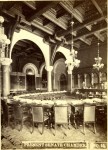 collections, professional organizations, local historical societies to pepper the statehouse with artifacts that tell the story of New York and the United States.
collections, professional organizations, local historical societies to pepper the statehouse with artifacts that tell the story of New York and the United States.
 Now visitors to the Capitol will find a wealth of exhibits arranged in its galleries according to theme. In the Hall of Governors, where governors of New York from the first one, George Clinton (the signer of the Declaration of the Independence, not the King of Interplanetary Funk) to the current one have worked, the official portraits of almost all of them line the walls.
Now visitors to the Capitol will find a wealth of exhibits arranged in its galleries according to theme. In the Hall of Governors, where governors of New York from the first one, George Clinton (the signer of the Declaration of the Independence, not the King of Interplanetary Funk) to the current one have worked, the official portraits of almost all of them line the walls. 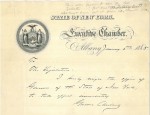 Several of those governors became Presidents of the United States, which makes the artifacts and documents from their gubernatorial terms take on national import. One of the documents on display is the resignation letter Grover Cleveland wrote on January 6, 1885, before he took up his duties as President. It is a masterpiece of concision.
Several of those governors became Presidents of the United States, which makes the artifacts and documents from their gubernatorial terms take on national import. One of the documents on display is the resignation letter Grover Cleveland wrote on January 6, 1885, before he took up his duties as President. It is a masterpiece of concision.
To The Legislators:
I hereby resign the office of Governor of the State of New York, to take effect immediately.
Grover Cleveland
 On the other side of the scale is a 1762 bill of sale for slaves, a mother and her two children. It makes a point of stating that the sale is done under the laws of British America, because slavery had already been outlawed in England itself.
On the other side of the scale is a 1762 bill of sale for slaves, a mother and her two children. It makes a point of stating that the sale is done under the laws of British America, because slavery had already been outlawed in England itself.
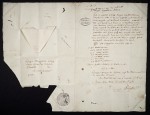 In the Governor’s Reception Room, the exhibit features documents and objects that illustrate the founding and growth of New York. The oldest document is a report written by Pieter Schaghen to the Dutch West India Company on November 5, 1626. In it Schaghen announces that they have purchased the island of Manhattan for the equivalent of 60 guilders. It’s the first documentary reference to the purchase of Manhattan.
In the Governor’s Reception Room, the exhibit features documents and objects that illustrate the founding and growth of New York. The oldest document is a report written by Pieter Schaghen to the Dutch West India Company on November 5, 1626. In it Schaghen announces that they have purchased the island of Manhattan for the equivalent of 60 guilders. It’s the first documentary reference to the purchase of Manhattan.
 The Flag Room has, not surprisingly, an impressive collection of flags from the New York State Military Museum, but as much as I like historic flags, I like historic hats even more, and they have a couple of splendid examples. One is a Chapeau-bras, meaning an arm-hat because it folds to carry easily under the arm. It belonged to New York State Militia officer Jacob DeForest before the Civil War.
The Flag Room has, not surprisingly, an impressive collection of flags from the New York State Military Museum, but as much as I like historic flags, I like historic hats even more, and they have a couple of splendid examples. One is a Chapeau-bras, meaning an arm-hat because it folds to carry easily under the arm. It belonged to New York State Militia officer Jacob DeForest before the Civil War. 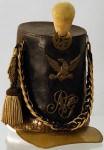 My other favorite is a Shako — a rather rococo cylindrical hat with a visor — from the 1840s that was once worn by a member of the 27th New York State Militia Artillery. It looks like something out of a Stendhal novel.
My other favorite is a Shako — a rather rococo cylindrical hat with a visor — from the 1840s that was once worn by a member of the 27th New York State Militia Artillery. It looks like something out of a Stendhal novel.
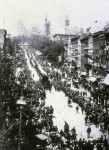 There’s also an exhibit dedicated to Ulysses S. Grant. He wasn’t a governor of New York, but he did die upstate in 1885. His body was transported to Albany for a public funeral complete with procession to the black-draped Capitol where his coffin was put on a bier and almost 100,000 people lined up to pay their respects. There’s a picture of the procession on display which is remarkable not only for the massive crowds and the views of the 19th century city, but for the extraordinary number of cables crisscrossing between the buildings. I knew Albany was one of the first cities to electrify, but 1885 seems awfully early to have such a mass of wires.
There’s also an exhibit dedicated to Ulysses S. Grant. He wasn’t a governor of New York, but he did die upstate in 1885. His body was transported to Albany for a public funeral complete with procession to the black-draped Capitol where his coffin was put on a bier and almost 100,000 people lined up to pay their respects. There’s a picture of the procession on display which is remarkable not only for the massive crowds and the views of the 19th century city, but for the extraordinary number of cables crisscrossing between the buildings. I knew Albany was one of the first cities to electrify, but 1885 seems awfully early to have such a mass of wires.
 Because I am a sucker for period vehicles, I simply must point out the exhibit in the concourse of the Empire State Plaza, the modern administrative complex that was built in the 60s and 70s and integrated with the Capitol. There’s a restored Adirondack guideboat from the early 19th century, a peddler’s wagon that sold tin in the Hudson Valley during the 1890s, and some exquisite high-end conveyances to transport governors: a seven-passenger Pierce-Arrow Type 43 from 1931, Franklin Delano Roosevelt’s 1932 Packard Phaeton which is still in the state fleet and was used to drive Queen Beatrix and Prince Claus of the Netherlands in style when they visited Albany in 1982. Also dreamy is the 1967 Lincoln Executive Limousine first used by Nelson Rockefeller and then by successive governors until 1988.
Because I am a sucker for period vehicles, I simply must point out the exhibit in the concourse of the Empire State Plaza, the modern administrative complex that was built in the 60s and 70s and integrated with the Capitol. There’s a restored Adirondack guideboat from the early 19th century, a peddler’s wagon that sold tin in the Hudson Valley during the 1890s, and some exquisite high-end conveyances to transport governors: a seven-passenger Pierce-Arrow Type 43 from 1931, Franklin Delano Roosevelt’s 1932 Packard Phaeton which is still in the state fleet and was used to drive Queen Beatrix and Prince Claus of the Netherlands in style when they visited Albany in 1982. Also dreamy is the 1967 Lincoln Executive Limousine first used by Nelson Rockefeller and then by successive governors until 1988.
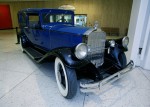
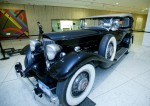
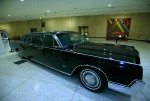
There’s piles more neat stuff to go through on the website — don’t miss the 1911 Capitol Fire online exhibit — but if you have a chance to go to Albany in person, make sure you put a visit to the Capitol on the itinerary. There are walk-in tours run four times a day, and you can get a self-guided audio tour to take you through the exhibits on your own time and schedule.